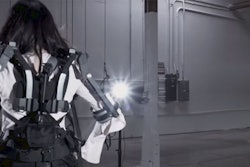Many of Kassy Hart’s first attempts at 3D printing didn’t end well.
Back in 2015, Hart was trying to print a special metal probe from a cobalt-chrome alloy at GE Power’s Advanced Manufacturing Works in Greenville, South Carolina. 3D printers build parts, step by tiny step, by fusing together superthin layers of fine metal powder with a laser or other powerful energy source.
Hart succeeded in printing her probe, a device called a super-rake, which gathers data during engine tests. But it ran right up to the edge of the printer’s build space — a high-tech “sandbox” holding the powder — giving her little wiggle room to remove it when it was finished. “It took technicians more than an hour of finagling it — cursing me the entire time,” she says ruefully.
Forgetting to leave room for retrieval wasn’t Hart’s only rookie mistake. Another time, she printed over the bolt securing the support plate under a part. When it came time to remove the piece, the team could barely access the bolt to get it out of the printer. “When you consider quality requirements, we didn’t print a single good part in the first four months due to the maturity of the technology and team,” she says. “Our motto was ‘Fail fast to learn fast.’”
She did. Hart, 30, is now a lead additive manufacturing engineer for GE Power. She discovered additive manufacturing, better known as 3D printing, just as the field was starting up. “A lot of times, there’s an expert somewhere to ask questions,” she says. “But it was just us and a few printers we’d never seen before, so we had to figure it out.”
The experience with 3D printing in Greenville was during her final rotation for GE’s Edison Engineering Development Program, a two- to three-year regimen for training talented engineers straight out of college. She started after finishing her graduate work at the University of Kentucky, rotating every six months through industrial assignments until she arrived at 3D printing.
She enjoyed it so much that when the last leg of the program was over, she decided to stay.
At the time, the Greenville plant didn’t even have a dedicated space for 3D printing development. “We were all learning one step — one mistake — at a time,” Hart says. “We were feeling our way through uncharted territory.”
But three years later, she and her team members are leading the field. They recently unveiled a 3D-printed fuel nozzle for GE’s latest HA-class gas turbine that’s setting efficiency records and making power plants cleaner and more cost-effective. The new nozzle, a key part of the turbine that mixes fuel and air and injects it into the combustion chamber, was crucial in helping to boost the HA turbine’s efficiency to 64 percent (among other forward-thinking upgrades). That’s higher than GE’s own record listed in Guinness World Records. The latest HA turbines will enter operation in the next few years.
There are fewer mistakes these days, but there’s still a locked scrap bin for discarded parts — ideas that didn’t work or parts that didn’t print out properly. The parts can take hours or days to print, and engineers must monitor them especially closely during the first few layers, when things are most likely to go wrong.
As for Hart, she’s still learning. A recent challenge was ensuring that 40 parts being printed simultaneously were laid out properly on the build plate. “Always check those bolt holes!” she says with a laugh.






















